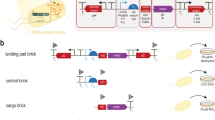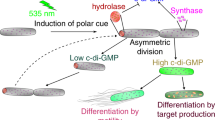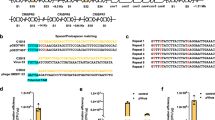Abstract
A major goal of synthetic biology is to reprogram cells to perform complex tasks. Here we show how a combination of in vitro and in vivo selection rapidly identifies a synthetic riboswitch that activates protein translation in response to the herbicide atrazine. We further demonstrate that this riboswitch can reprogram bacteria to migrate in the presence of atrazine. Finally, we show that incorporating a gene from an atrazine catabolic pathway allows these cells to seek and destroy atrazine.
This is a preview of subscription content, access via your institution
Access options
Subscribe to this journal
Receive 12 print issues and online access
$259.00 per year
only $21.58 per issue
Buy this article
- Purchase on Springer Link
- Instant access to full article PDF
Prices may be subject to local taxes which are calculated during checkout






Similar content being viewed by others
References
Parkinson, J.S., Ames, P. & Studdert, C.A. Collaborative signaling by bacterial chemoreceptors. Curr. Opin. Microbiol. 8, 116–121 (2005).
Wadhams, G.H. & Armitage, J.P. Making sense of it all: bacterial chemotaxis. Nat. Rev. Mol. Cell Biol. 5, 1024–1037 (2004).
Adler, J. Chemotaxis in bacteria. Annu. Rev. Biochem. 44, 341–356 (1975).
Derr, P., Boder, E. & Goulian, M. Changing the specificity of a bacterial chemoreceptor. J. Mol. Biol. 355, 923–932 (2006).
Matsumura, I. & Ellington, A.D. In vitro evolution of β-glucuronidase into a β-galactosidase proceeds through non-specific intermediates. J. Mol. Biol. 305, 331–339 (2001).
Aharoni, A. et al. The “evolvability” of promiscuous protein functions. Nat. Genet. 37, 73–76 (2005).
Goldberg, S.D., Derr, P., DeGrado, W.F. & Goulian, M. Engineered single- and multi-cell chemotaxis pathways in E. coli. Mol. Syst. Biol. 5, 283 (2009).
Ellington, A.D. & Szostak, J.W. In vitro selection of RNA molecules that bind specific ligands. Nature 346, 818–822 (1990).
Tuerk, C. & Gold, L. Systematic evolution of ligands by exponential enrichment: RNA ligands to bacteriophage T4 DNA polymerase. Science 249, 505–510 (1990).
Werstuck, G. & Green, M.R. Controlling gene expression in living cells through small molecule-RNA interactions. Science 282, 296–298 (1998).
Desai, S.K. & Gallivan, J.P. Genetic screens and selections for small molecules based on a synthetic riboswitch that activates protein translation. J. Am. Chem. Soc. 126, 13247–13254 (2004).
Topp, S. & Gallivan, J.P. Guiding bacteria with small molecules and RNA. J. Am. Chem. Soc. 129, 6807–6811 (2007).
Lynch, S.A., Desai, S.K., Sajja, H.K. & Gallivan, J.P. A high-throughput screen for synthetic riboswitches reveals mechanistic insights into their function. Chem. Biol. 14, 173–184 (2007).
Topp, S. & Gallivan, J.P. Random walks to synthetic riboswitches—a high-throughput selection based on cell motility. ChemBioChem 9, 210–213 (2008).
Topp, S. & Gallivan, J.P. Riboswitches in unexpected places—a synthetic riboswitch in a protein coding region. RNA 14, 2498–2503 (2008).
Lynch, S.A. & Gallivan, J.P. A flow cytometry-based screen for synthetic riboswitches. Nucleic Acids Res. 37, 184–192 (2009).
Muranaka, N., Sharma, V., Nomura, Y. & Yokobayashi, Y. An efficient platform for genetic selection and screening of gene switches in Escherichia coli. Nucleic Acids Res. 37, e39 (2009).
Muranaka, N., Abe, K. & Yokobayashi, Y. Mechanism-guided library design and dual genetic selection of synthetic OFF riboswitches. ChemBioChem 10, 2375–2381 (2009).
Kotter, P., Weigand, J.E., Meyer, B., Entian, K.D. & Suess, B. A fast and efficient translational control system for conditional expression of yeast genes. Nucleic Acids Res. 37, e120 (2009).
Hunsicker, A. et al. An RNA aptamer that induces transcription. Chem. Biol. 16, 173–180 (2009).
Hering, O., Brenneis, M., Beer, J., Suess, B. & Soppa, J. A novel mechanism for translation initiation operates in haloarchaea. Mol. Microbiol. 71, 1451–1463 (2009).
Weigand, J.E. et al. Screening for engineered neomycin riboswitches that control translation initiation. RNA 14, 89–97 (2008).
Sharma, V., Nomura, Y. & Yokobayashi, Y. Engineering complex riboswitch regulation by dual genetic selection. J. Am. Chem. Soc. 130, 16310–16315 (2008).
Weigand, J.E. & Suess, B. A designed RNA shuts down transcription. Chem. Biol. 14, 9–11 (2007).
Nomura, Y. & Yokobayashi, Y. Dual selection of a genetic switch by a single selection marker. Biosystems 90, 115–120 (2007).
Hanson, S., Bauer, G., Fink, B. & Suess, B. Molecular analysis of a synthetic tetracycline-binding riboswitch. RNA 11, 503–511 (2005).
Suess, B., Fink, B., Berens, C., Stentz, R. & Hillen, W. A theophylline responsive riboswitch based on helix slipping controls gene expression in vivo. Nucleic Acids Res. 32, 1610–1614 (2004).
Buskirk, A.R., Landrigan, A. & Liu, D.R. Engineering a ligand-dependent RNA transcriptional activator. Chem. Biol. 11, 1157–1163 (2004).
Thompson, K.M., Syrett, H.A., Knudsen, S.M. & Ellington, A.D. Group I aptazymes as genetic regulatory switches. BMC Biotechnol. 2, 21 (2002).
Win, M.N. & Smolke, C.D. A modular and extensible RNA-based gene-regulatory platform for engineering cellular function. Proc. Natl. Acad. Sci. USA 104, 14283–14288 (2007).
Jenison, R.D., Gill, S.C., Pardi, A. & Polisky, B. High-resolution molecular discrimination by RNA. Science 263, 1425–1429 (1994).
Berens, C., Thain, A. & Schroeder, R. A tetracycline-binding RNA aptamer. Bioorg. Med. Chem. 9, 2549–2556 (2001).
Wallis, M.G., von Ahsen, U., Schroeder, R. & Famulok, M. A novel RNA motif for neomycin recognition. Chem. Biol. 2, 543–552 (1995).
Wang, Y., Killian, J., Hamasaki, K. & Rando, R.R. RNA molecules that specifically and stoichiometrically bind aminoglycoside antibiotics with high affinities. Biochemistry 35, 12338–12346 (1996).
Wang, L. et al. Biodegradation of atrazine in transgenic plants expressing a modified bacterial atrazine chlorohydrolase (atzA) gene. Plant Biotechnol. J. 3, 475–486 (2005).
de Souza, M.L., Seffernick, J., Martinez, B., Sadowsky, M.J. & Wackett, L.P. The atrazine catabolism genes atzABC are widespread and highly conserved. J. Bacteriol. 180, 1951–1954 (1998).
de Souza, M.L. et al. Molecular basis of a bacterial consortium: interspecies catabolism of atrazine. Appl. Environ. Microbiol. 64, 178–184 (1998).
de Souza, M.L., Sadowsky, M.J. & Wackett, L.P. Atrazine chlorohydrolase from Pseudomonas sp. strain ADP: gene sequence, enzyme purification, and protein characterization. J. Bacteriol. 178, 4894–4900 (1996).
Scott, C. et al. Catalytic improvement and evolution of atrazine chlorohydrolase. Appl. Environ. Microbiol. 75, 2184–2191 (2009).
Regulski, E.E. & Breaker, R.R. In-line probing analysis of riboswitches. Methods Mol. Biol. 419, 53–67 (2008).
Soukup, G.A. & Breaker, R.R. Relationship between internucleotide linkage geometry and the stability of RNA. RNA 5, 1308–1325 (1999).
Mandelbaum, R.T., Allan, D.L. & Wackett, L.P. Isolation and characterization of a Pseudomonas sp. that mineralizes the s-triazine herbicide atrazine. Appl. Environ. Microbiol. 61, 1451–1457 (1995).
Clay, S.A. & Koskinen, W.C. Adsorption and desorption of atrazine, hydroxyatrazine, and S-glutathione atrazine on 2 soils. Weed Sci. 38, 262–266 (1990).
Wackett, L.P., Sadowsky, M.J., Martinez, B. & Shapir, N. Biodegradation of atrazine and related s-triazine compounds: from enzymes to field studies. Appl. Microbiol. Biotechnol. 58, 39–45 (2002).
Adler, J. Chemotaxis in bacteria. Science 153, 708–716 (1966).
Budrene, E.O. & Berg, H.C. Complex patterns formed by motile cells of Escherichia coli. Nature 349, 630–633 (1991).
Baba, T. et al. Construction of Escherichia coli K-12 in-frame, single-gene knockout mutants: the Keio collection. Mol. Syst. Biol. 2, 1–11 (2006).
Zuker, M. Mfold web server for nucleic acid folding and hybridization prediction. Nucleic Acids Res. 31, 3406–3415 (2003).
Mathews, D.H., Sabina, J., Zuker, M. & Turner, D.H. Expanded sequence dependence of thermodynamic parameters improves prediction of RNA secondary structure. J. Mol. Biol. 288, 911–940 (1999).
Acknowledgements
This research was supported by the US National Institutes of Health (GM074070 to J.P.G.), the Arnold and Mabel Beckman Foundation and the Herman Frasch Foundation of the American Chemical Society. J.P.G. is a Camille Dreyfus Teacher-Scholar and an Alfred P. Sloan Research Fellow. We thank S. Topp for helpful discussions.
Author information
Authors and Affiliations
Contributions
J.P.G. conceived the research. J.S. performed the molecular and microbiology experiments; S.J.R. carried out the synthetic chemistry. J.S. and J.P.G. analyzed data and wrote the paper.
Corresponding author
Ethics declarations
Competing interests
The authors declare no competing financial interests.
Supplementary information
Supplementary Text and Figures
Supplementary Methods and Supplementary Figures 1–9 (PDF 1753 kb)
Rights and permissions
About this article
Cite this article
Sinha, J., Reyes, S. & Gallivan, J. Reprogramming bacteria to seek and destroy an herbicide. Nat Chem Biol 6, 464–470 (2010). https://doi.org/10.1038/nchembio.369
Received:
Accepted:
Published:
Issue Date:
DOI: https://doi.org/10.1038/nchembio.369
This article is cited by
-
Tighter Bounds on Transient Moments of Stochastic Chemical Systems
Journal of Optimization Theory and Applications (2024)
-
An overview and future prospects on aptamers for food safety
Applied Microbiology and Biotechnology (2020)
-
Engineering a vitamin B12 high-throughput screening system by riboswitch sensor in Sinorhizobium meliloti
BMC Biotechnology (2018)
-
Transcriptional control of motility enables directional movement of Escherichia coli in a signal gradient
Scientific Reports (2017)
-
Aptamers as a novel tool for diagnostics and therapy
Investigational New Drugs (2015)



